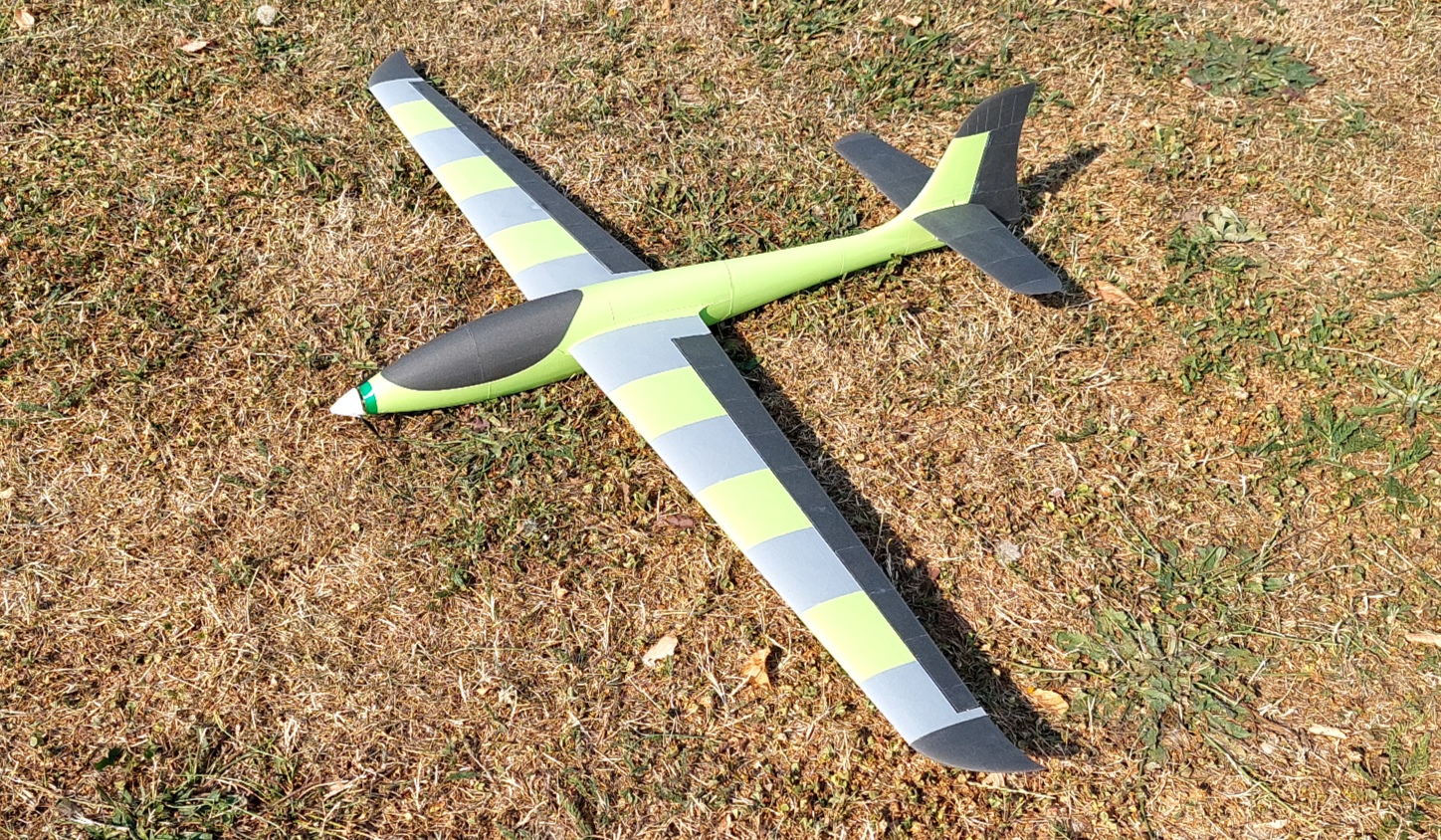
Little Acro
prusaprinters
<h3>CArts Little Acro</h3><figure class="media"><oembed url="https://youtu.be/BSN1zy7ekSU"></oembed></figure><ul><li><strong>Span:</strong> approx. 1200 mm</li><li><strong>Body length:</strong> approx. 720 mm</li><li><strong>Take-off weight (LW-PLA):</strong> approx. 450 g</li><li><strong>Drive:</strong> brushless motor (up to 28mm diameter, 25mm length)</li><li><strong>Propeller :</strong> folding propeller</li><li><strong>Battery:</strong> 2S-3S Lipo 500-1000 mAh</li><li><strong>Controls:</strong> elevator / rudder / aileron (flaperon +-10°) / motor</li><li><strong>Center of gravity:</strong> 35 mm behind the profile nose</li><li><strong>Rudder deflections:</strong> 20-30 °</li></ul><p>After months of designing and testing it's finally done!<br>The <strong>CArts Little Acro</strong> flies well and the files are out on prusaprinters.org.</p><p>A complete building instructuion video playlist is availlable on youtube:<br><a href="https://youtube.com/playlist?list=PL_Xygo8HOuZYOVOCS-hpXX4jV9SNNkQri">https://youtube.com/playlist?list=PL_Xygo8HOuZYOVOCS-hpXX4jV9SNNkQri</a></p><p>The Little Acro is a small electrically powered acrobatic sail plane, that easily fits in almost every car trunk. The wing is in one part, screwed to the fuselage. But it can be detached to service the servos in the fuselage.</p><p>As a pilot you should have some experience, as in my opinion 3d-printed models are not suitable for beginners. The model is capable of rolls, loops, inverted flying and maybe more. But as I'm not a very experienced acrobatic pilot, I didn't try out more, yet.</p><p>If you decide to build the model, I would appreciate a short report on your experience in the comments or you can contact me via the prusaprinter messenger.<br>This would help me a lot to improve the design my new models or to fix errors in the actual models.</p><p>The Little Acro should be printed from lightweight PLA (LW-PLA). The construction of the parts is designed for a minimum of retracts is necessary when printing. This minimizes stringing when using LW-PLA. Some parts however must be printed in PLA or PETG.</p><p>The individual parts should also be printed individually. Otherwise the stringing will be too strong and the post-processing of the parts will be too time-consuming.<br>The overall printing time is about 100 hours.</p><p><strong>Modifiers</strong> are used in the print files . These are essential for the stability and for the structure of the individual parts! The surfaces for connecting the individual parts are made by using <strong>modifiers</strong> .</p><h3> </h3><h3>Parts for the construction</h3><p>Carbon / rods or fiberglass rods as well as various adhesives are required for the construction.</p><h4>Adhesives</h4><ul><li>Superglue, low viscosity</li></ul><h4>Carbon rods</h4><ul><li>Carbon rod 1 mm: 4 pieces (465 mm length)</li><li>Carbon rod 1 mm: 1 piece (525 mm length)</li><li>Carbon rod 1 mm: 2 pieces (500 mm length)</li><li>Carbon rod 1 mm: 1 piece (200 mm length)</li><li> </li><li>Carbon rod 1.5 mm: 2 pieces (1000 mm length)</li><li> </li><li>Carbon rod 2 mm: 1 piece (125 mm length)</li><li>Carbon rod 2 mm: 1 piece (110 mm length)</li><li> </li><li>Carbon tube 3 mm: 1 piece (180 mm length)</li><li> </li><li>Carbon bar 0,5 x 6 mm: 1 piece (450mm length)</li></ul><p> </p><p>For the elevator push-rod:</p><ul><li>Carbon rod 2mm (500mm length)<br>(alternately steel wire 2mm)</li></ul><h4>Steel wire</h4><ul><li>Steel wire 1 mm: 1 piece (500 mm length)</li></ul><h4>Bowden Tube</h4><ul><li>Outer diameter 3 mm: 1 piece (500 mm length)</li></ul><h4>Magnets</h4><ul><li>Neodymium magnet round 8x2 mm (d x h): 1 piece</li><li>sheet iron 1x8x30mm (t x w x l): 1 piece</li></ul><h4>Screws</h4><ul><li>Wood screws 2x10 mm (d x h): ca. 20 pieces</li><li>Wood screws 2x16 mm (d x h): 4 pieces</li><li>Screw M3x10 mm: 4 pieces (for the motor mount)</li><li>Washers M3: 4 pieces</li></ul><h3>Electronics</h3><h4>Servos</h4><ul><li>Micro servos: 2 pieces in the wings<br>(maximum dimensions (L x W x H) 23.5 x 10 x 24 mm)</li><li>Two 9g Mini-Servos in the fuselage<br> </li></ul><p>I use high quality servos with metal gears. These can cope with even greater loads (e.g. in the event of undesired contact with the ground) without damage. The additional costs for this are worthwhile.</p><h4>Receiver</h4><ul><li>Minimum: 5 channels</li></ul><h4>Engine</h4><ul><li>Brushless motor (maximum dimensions (d x H) 28 x 25 mm)</li></ul><h4>ESC (controller)</h4><ul><li>Minimum: 20A (3-4S)</li><li>BEC minimum: 2A</li></ul><h3>How I set up Prusaslicer for my printer:</h3><figure class="media"><oembed url="https://youtu.be/wvLSVYyUMD8"></oembed></figure><h3> </h3><h3>Fuselage build videos:</h3><figure class="media"><oembed url="https://youtu.be/eFf7pY4wHMs"></oembed></figure><figure class="media"><oembed url="https://youtu.be/-rWlaXNkLDc"></oembed></figure><figure class="media"><oembed url="https://youtu.be/_8nfXYenXaQ"></oembed></figure><figure class="media"><oembed url="https://youtu.be/bfB5ODWH8NY"></oembed></figure><figure class="media"><oembed url="https://youtu.be/t0GOuz2S1tA"></oembed></figure><figure class="media"><oembed url="https://youtu.be/xtZmuO5_iTg"></oembed></figure><figure class="media"><oembed url="https://youtu.be/TSqN78I3B9Q"></oembed></figure><figure class="media"><oembed url="https://youtu.be/mPPWx0p4pM4"></oembed></figure><figure class="media"><oembed url="https://youtu.be/YfRCbOILxeU"></oembed></figure><figure class="media"><oembed url="https://youtu.be/lzVISJLWT2E"></oembed></figure><figure class="media"><oembed url="https://youtu.be/AO5Z3y6MGLs"></oembed></figure><figure class="media"><oembed url="https://youtu.be/tWpe_ajxeoY"></oembed></figure><figure class="media"><oembed url="https://youtu.be/RFk-TfuTj6U"></oembed></figure><figure class="media"><oembed url="https://youtu.be/HYehsXjTk24"></oembed></figure><figure class="media"><oembed url="https://youtu.be/h8DNKHFvQGo"></oembed></figure><h3> </h3><h3>Wing build videos:</h3><figure class="media"><oembed url="https://youtu.be/V959Rf1IWU4"></oembed></figure><figure class="media"><oembed url="https://youtu.be/zs4wB2lm3UU"></oembed></figure><figure class="media"><oembed url="https://youtu.be/5wX-DNgvt4g"></oembed></figure><figure class="media"><oembed url="https://youtu.be/GX6ZKEfWHe4"></oembed></figure><figure class="media"><oembed url="https://youtu.be/fMbxX9Mre54"></oembed></figure><figure class="media"><oembed url="https://youtu.be/FMKVubnx83o"></oembed></figure>
With this file you will be able to print Little Acro with your 3D printer. Click on the button and save the file on your computer to work, edit or customize your design. You can also find more 3D designs for printers on Little Acro.
